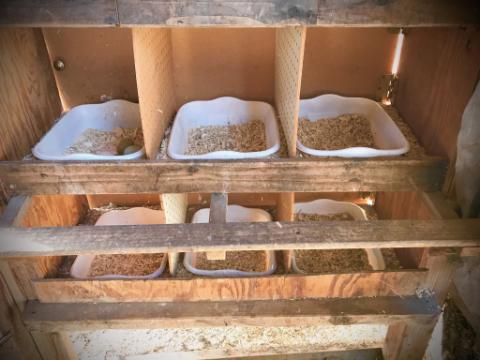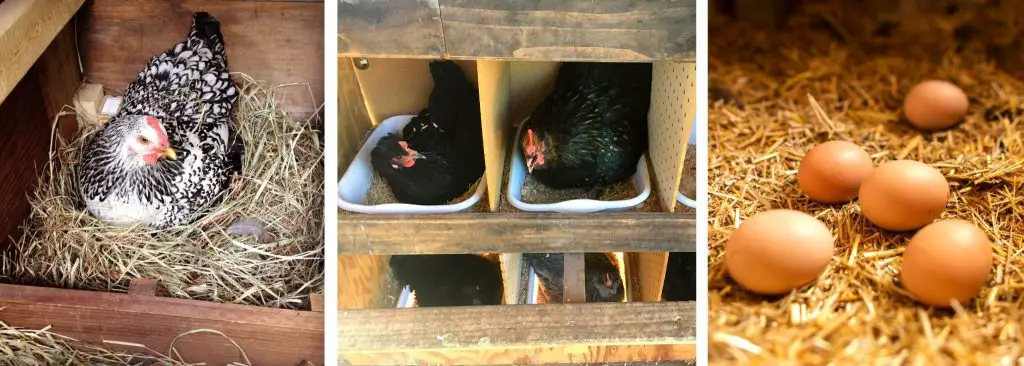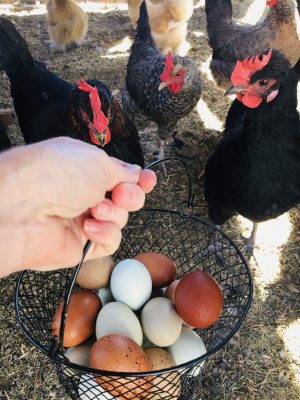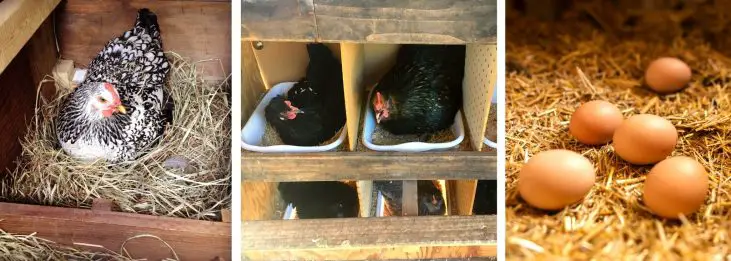
Taking care of our chicken companions is a joy, and when it comes to their cozy nesting boxes, a few extra touches can make all the difference. Here are the top four things you should put inside your chicken’s nesting boxes for ultimate comfort and egg-laying bliss. In this article, we’ll discuss the following topics in more detail:
- Nesting Material
- Nesting Box Herbs
- Fake Eggs
- Privacy Curtains
Nesting Box Calculator
| Number of Hens | Number of Nesting Boxes Needed |
|---|---|
| 0 |
1. Nesting Material: Selecting Optimal Bedding for Chicken Nesting Boxes
Pine Shavings:

Pine shavings are my number one choice for nesting material. They are very absorbent and do a great job at controlling odors.
Pros of using pine shavings in nesting boxes:
- create a soft and dry nesting environment for hens
- promote a hygienic space for egg-laying
- discourage pests, contributing to a healthier coop
- easy to maintain nesting boxes
- mixes well with nesting box herbs (more on this below)
Straw:
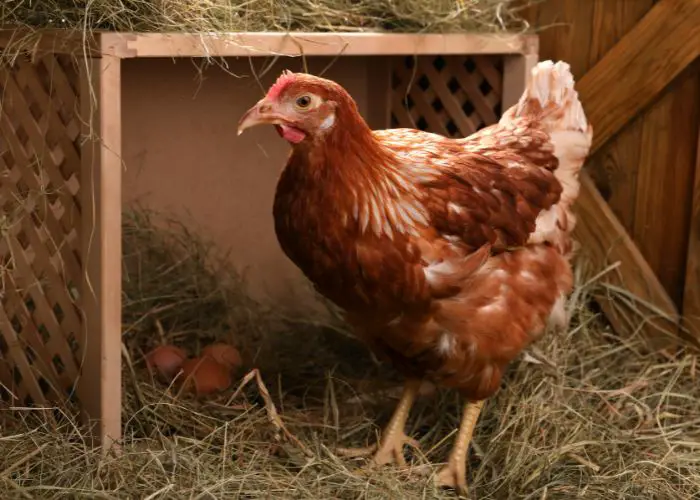
Straw is a popular and cost-effective bedding option for chicken nesting boxes.
Pros of using straw in nesting boxes:
- Its insulating properties provide warmth and comfort to hens during egg-laying.
- Additionally, straw is readily available, making it a convenient choice for many chicken keepers.
- Affordability and natural composition make it an environmentally friendly option.
- Chickens often find straw cozy and enjoy arranging it to suit their nesting preferences.
Excelsior Pads:
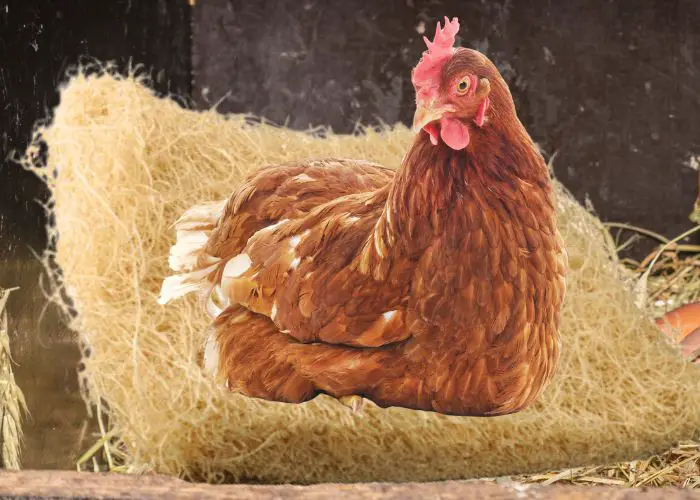
Excelsior pads are specialized nesting materials made from shredded wood fibers, typically aspen wood. These pads are designed to line chicken nesting boxes, providing a comfortable and clean environment for hens to lay eggs. Excelsior pads are renowned for their moisture-wicking properties.
Pros of using excelsior pads in nesting boxes:
- The shredded wood fibers create a soft and insulating surface, offering a cozy space that encourages hens to nest comfortably.
- efficiently absorbs excess moisture and keep the nesting area dry.
- great at preventing the growth of bacteria, contributing to a healthier nesting environment
- easy to clean and replace, promoting better hygiene in the chicken coop
- promoting better hygiene in the chicken coop.
- discourages pests and mites, offering an added layer of protection for both the eggs and the nesting hens.
In summary, excelsior pads serve as an excellent bedding option for chicken nesting boxes, providing comfort, moisture control, and ease of maintenance, all contributing to the well-being of both the chickens and the eggs.
Other Nesting Material Options for Nesting Boxes:
- Hay:
- Pros: Similar to straw, hay is readily available and offers a cozy environment. Chickens may also enjoy nibbling on it.
- Shredded Paper:
- Pros: Cost-effective and readily available. Provides a soft surface for egg-laying.
- Cons: Not as absorbent. Needs to be changed out more frequently.
- Grass Clippings:
- Pros: Eco-friendly and cost-free if you have a lawn. Chickens may enjoy the natural feel.
- Tip: Don’t use fertilized lawn clippings for bedding material.
Remember, the key is to maintain cleanliness by regularly replacing soiled bedding. Each option has its advantages, so consider factors like availability, cost, and your chickens’ preferences when making a choice.
2. Nesting Box Herbs to Encourage Egg Laying
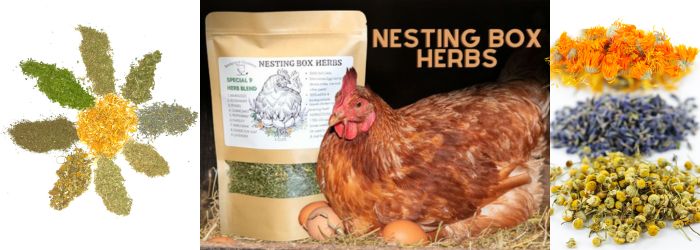
Adding herbs to chicken nesting boxes is not only a delightful experience for the hens but also offers numerous benefits for both the chickens and their owners. Here’s why incorporating Nesting Box Herbs for Chickens, like the ones available at Backyard Chickens Mama, can be advantageous:
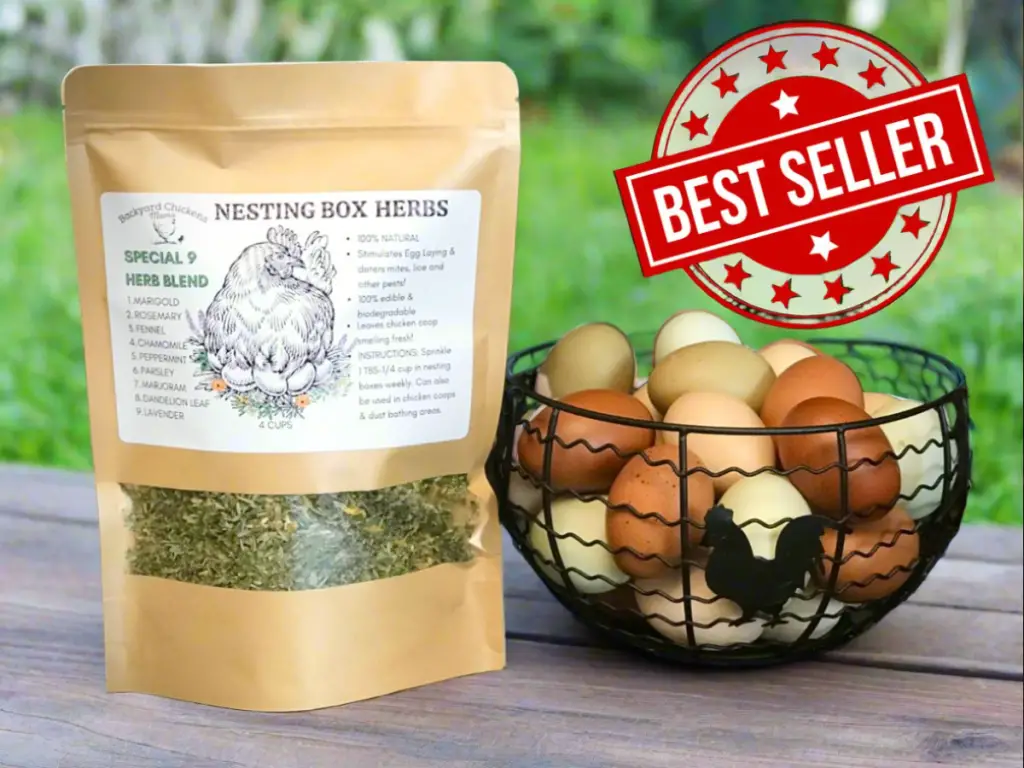
Increases egg laying naturally.
- Improves chicken health.
- Deters parasites: mites, lice, fleas, flies & rodents.
- On SALE!
- SHOP NOW
- Stress Reduction: Herbs such as lavender and chamomile possess calming properties. Placing these herbs in nesting boxes creates a soothing environment, reducing stress for the hens. Relaxed chickens are more likely to lay eggs consistently and exhibit healthier behaviors.
- Aromatherapy for Hens: Certain herbs, like peppermint and rosemary, provide aromatic benefits. Aromatherapy in the coop promotes a sense of well-being for the chickens. It can positively impact their mood, leading to a more contented flock.
- Natural Pest Control: Some herbs, including peppermint and calendula, have natural pest-repelling properties. Placing these herbs in nesting boxes can help deter pests like mites and lice, contributing to the overall health of the chickens.
- Egg Quality and Aroma: Herbs like parsley and dill may enhance the flavor of eggs and add a pleasant aroma. While this benefit is more subtle, it can contribute to a more enjoyable experience for egg collection and consumption.
- Connection with Nature: For chicken owners, incorporating herbs into nesting boxes creates a connection with nature. It adds an element of natural care and promotes a holistic approach to chicken keeping.
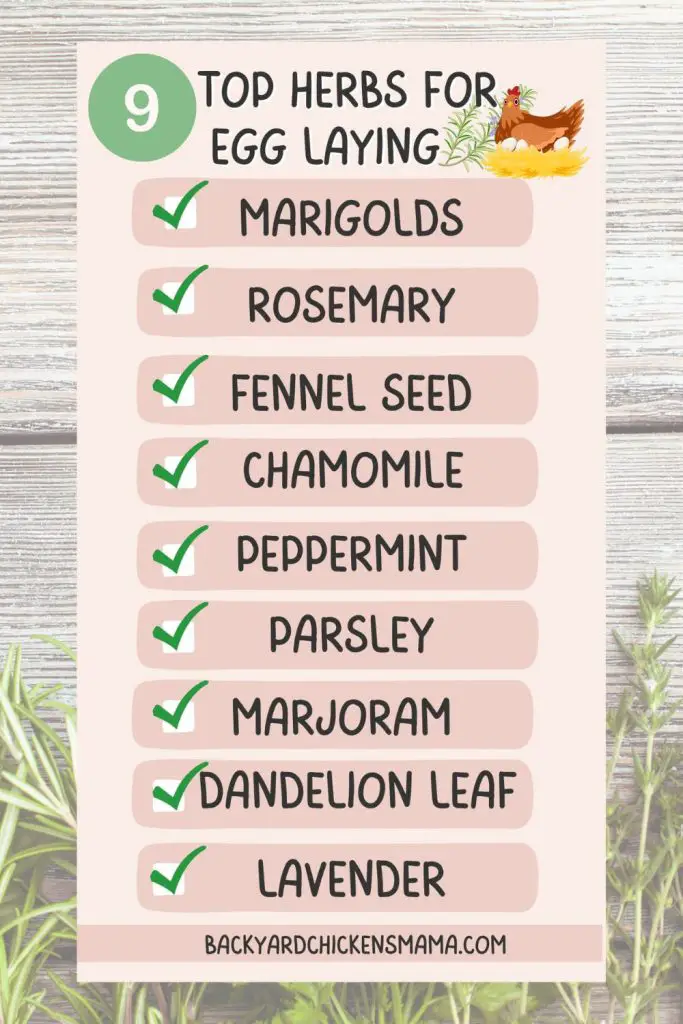
By integrating Nesting Box Herbs for Chickens, owners can create a harmonious and beneficial environment that supports the well-being of both the hens and the entire flock.
3. Fake Eggs for Encouragement
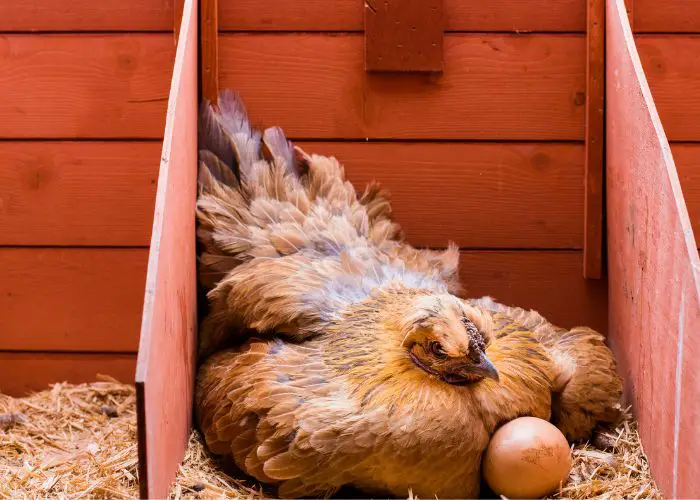
Fake eggs are a valuable tool for encouraging hens to lay eggs in designated nesting boxes. Here’s a step-by-step guide on how to use fake eggs effectively and the reasons behind their usage:
- Placement: Introduce fake eggs into nesting boxes where you want your hens to lay. Ensure the fake eggs are visible and easily accessible to the chickens.
- Encouraging Nesting Behavior: Chickens are naturally drawn to lay eggs where they see others have laid before. Fake eggs mimic the presence of real eggs, encouraging hens to use the designated nesting area.
- Training Young Hens: For pullets or new layers, fake eggs serve as visual cues, guiding them to the correct location for egg-laying. It establishes a pattern for them to follow, preventing undesirable laying locations.
- Preventing Egg Eating: In some cases, hens may develop a habit of eating their own eggs. Introducing fake eggs can deter this behavior as the hens learn that eggs in the nesting box are not edible.
- Minimizing Stress: Chickens are creatures of habit, and changes in their environment can cause stress. Fake eggs help maintain a consistent egg-laying routine, reducing stress and promoting a calm and productive coop atmosphere.
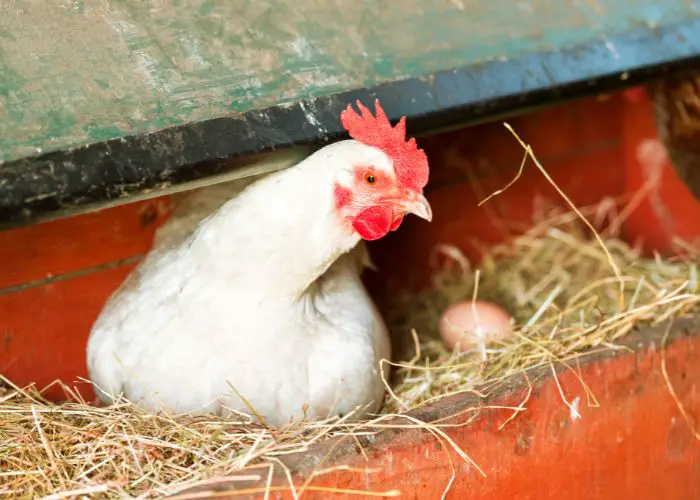
Using fake eggs in chicken nesting boxes is a practical strategy for managing egg-laying behavior, ensuring cleaner and more accessible eggs. By providing a familiar and appealing environment, fake eggs contribute to the overall well-being of the flock and the quality of collected eggs.
4. Privacy Curtains: Benefits of Adding Curtains to Chicken Nesting Boxes
Adding curtains to chicken nesting boxes offers several advantages for both the hens and their owners:
- Privacy for Laying Hens: Curtains provide a secluded space for hens to lay eggs, reducing stress and distraction. This privacy mimics the natural nesting instincts of chickens, promoting a comfortable environment for egg-laying.
- Egg Protection: Curtains act as a barrier, shielding freshly laid eggs from view. This can prevent other curious hens from pecking or eating the eggs, reducing the likelihood of egg cannibalism. The curtains create a sense of “out of sight, out of mind,” discouraging egg-related behavioral issues.
- Broody Hen Management: In cases where a hen becomes broody (excessively protective of eggs), curtains can help manage this behavior. By obscuring the view of eggs, curtains may discourage broodiness and promote a healthier egg-laying routine.
- Temperature Regulation: Curtains can aid in temperature control within the nesting boxes. During colder weather, they provide insulation, keeping the eggs warmer. In contrast, during hot weather, curtains can offer shade and ventilation, ensuring a more conducive environment for egg-laying.
- Prevention of Egg Eating: Curtains obstruct the view of laid eggs, reducing the temptation for chickens to eat them. This helps maintain a cleaner nesting area and preserves the quality of eggs for collection.
Before implementing curtains, it’s essential to observe the specific needs and behaviors of the flock, adjusting the setup accordingly. These curtains contribute to a conducive and stress-free environment, fostering healthy egg-laying habits.
Conclusion: What to Put in Chicken’s Nesting Boxes
Making chicken nesting boxes as comfortable as possible is essential for promoting a positive laying environment, ensuring the health of the hens, and maximizing egg production and quality.
- Select a good nesting material for your hens nesting boxes. Pine shavings, straw and excelsior pads are all good choices.
- Sprinkle some nesting box herbs inside the laying boxes to help create a more calm and inviting environment.
- Using fake eggs can encourage new hens to lay in the nesting box and seasoned layers to continue laying in them.
- For privacy, consider installing some privacy curtains for your hens boxes. They prefer laying in dark, secluded areas. This helps them feel safe.

